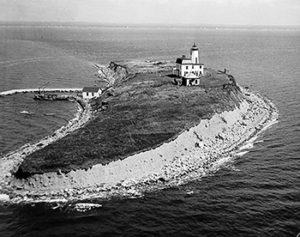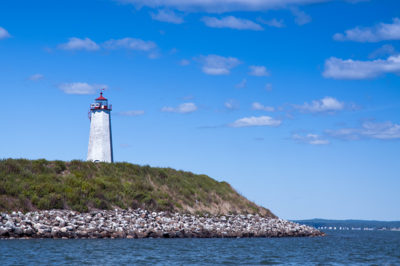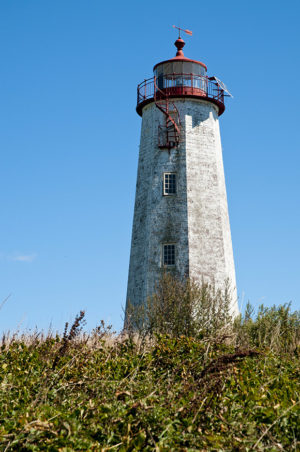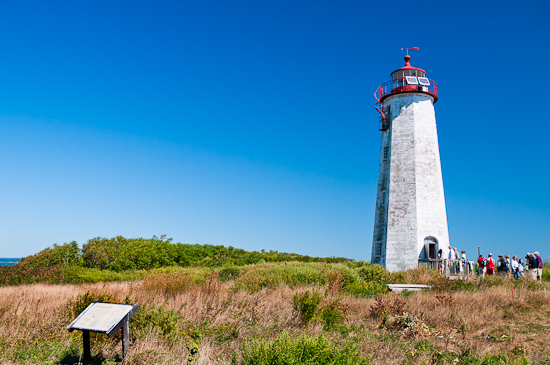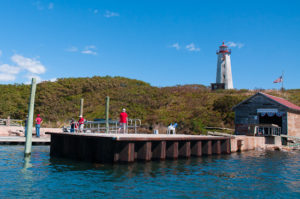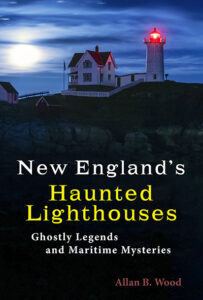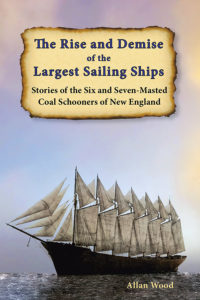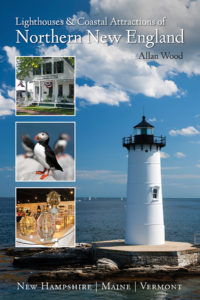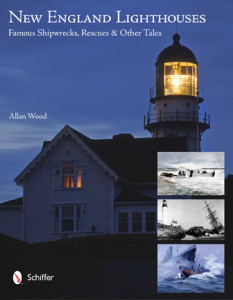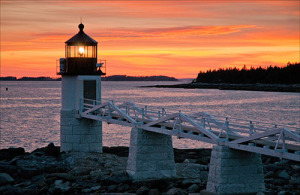Keeper Oliver Brooks and Two of His Famous Rescues By Faulkner’s Island Lighthouse in Connecticut
Keeper Oliver N. Brooks served as keeper at Faulkner’s Island lighthouse from 1851 to 1882 and was known to be one of New England’s most experienced, colorful, and talented keepers. He was an expert at handling small boats in all kinds of weather and frequently used a small 18-foot boat with a sail and long oars. He is credited with assisting in 71 rescues during his tenure. Two of his most famous different rescues involve the wreck of the Moses F Webb and, years later, the E. A. Woodward
The Rescue of the Moses F Webb
One of the most famous rescues in the Connecticut region occurred during his tenure at the lighthouse and challenged his skills as an expert boatman. On November 27, 1858, the Moses F. Webb was anchored at about 5 p.m. between Bruce Island and Faulkner’s Island for shelter for the night. She was coming from Brunswick, New Jersey, with a load of coal heading for Hartford, Connecticut.
By morning, the gale-force winds continued to worsen, and the Moses F. Webb started to drag her anchor along the bottom. The raging waves pounded and thrashed the vessel, forcing the anchor chains to break apart. The vessel was floundering in the heavy seas, heading towards Bruce Island, about a mile from Faulkner’s Island.
Keeper Brooks was on the lookout all night and saw the perilous incident that morning while looking through his spyglass. He could see the panic on board the Moses F Webb and everyone trying to climb and attach themselves to the rigging through the mountainous waves and piercing winds.
One of the survivors he saw was a woman (the captain’s wife). He watched as a toddler was given to a sailor, who tried to hold on to the little girl as best he could, but as the ship pitched and rolled from the raging seas, he watched in horror as the agonized sailor lost his grip of her when a huge wave washed over the deck of the ship. The little girl was washed into the freezing waters and did not survive.
Brooks knew he had to do something and probably wouldn’t survive the attempted rescue with his tiny boat in such turbulent seas. He told his young assistant keeper, Al Schofield, that he might not make it back and that if he should perish, to keep the light burning until someone could make it to the island to relieve him. He also told him to watch the children closely as his wife had gone ashore the day before the storm to get supplies. He gathered woolen blankets and provisions and set out in his small 18-foot boat.
As soon as he launched the boat and started battling the heaving waves, the winds shifted and grew stronger. The effort was daunting as he continued to row, and he often felt it would be impossible. It took quite some time, but he finally reached the stranded vessel, where he found five people clinging to the rigging for dear life. As the wreck was located closer to Bruce Island than Faulkner’s Island, he decided to bring the survivors to Bruce Island first.
One by one, Brooks transported each survivor to Bruce Island, put warm blankets around them, and made them as comfortable as possible. A few hours later, when they had regained strength and the winds had started to subside, he brought each survivor through the still unsettling seas and wind gusts to Faulkner’s Island, where his children waited for him and helped the survivors into their warm dwelling. He learned that the little girl he had watched drown was the captain’s daughter and that his wife was unaware of the incident.
Brooks and his family nursed the survivors back to health at the keeper’s house, and he became a local and national hero as all the newspapers carried his story. He received a Gold Lifesaving Medal from the New York Life Saving Society. The medal has an engraving on the back of the Moses F Webb being rescued by Brooks in his tiny craft.
The Rescue of the Paddlewheel Steamer E. A. Woodward
Many years later, another famous rescue serving as a testament to his valor and uncompromising character involves an incident near Thanksgiving in 1875. He was much older and so sick he was bedridden, which many believe was the flu. The paddlewheel steamer E. A. Woodward was making her way near the island in gale-force winds when the captain, thinking he was going around a buoy, hit an exposed rocky ledge and broke the propeller. The family saw and heard the vessel in distress and blew horns to indicate they were nearby. The ship was caught in the high winds and waves and tossed about, heading towards the rocky shoreline of Faulkner’s island.
Against all the family’s wishes, the exhausted Brooks grabbed some clothes and went out into the gale to try to put together a line to help those stranded on the craft. The lifeline was too short, so with quick thinking, he decided to run back to the house and stripped the beds of the cords that created bed boards under the mattresses and was able to splice enough cordage to get the line to the stranded crew. One by one, he was able to bring them safely to shore. With his successful efforts, he helped his family create a Thanksgiving dinner for his grateful guests instead of returning to his warm bed.
Exploring Faulkner’s Island
Today, the lighthouse is protected by the Faulkner’s Light Brigade organization. Faulkner’s Island is part of the Stewart B McKinney Wildlife Refuge as a protected bird sanctuary. In August, there is an annual open house for the public to explore certain selected areas of the grounds and lighthouse, promoted with transportation provided by the Faulkner’s Light Brigade out of Guilford Harbor. It is an excellent opportunity to visit the tower and learn about the birds protected by the naturalists who work there.
Here are some photos I’ve taken of Faulker’s Island Lighthouse.
For more information or to donate to restoration efforts, contact the Faulkner’s Light Brigade, P.O. Box 199, Guilford, Connecticut 06437.
Phone: (203) 453-8400
Faulkner’s Light Brigade Website
Enjoy the tour next summer!
Allan Wood
Books to Explore
New England’s Haunted Lighthouses:
Ghostly Legends and Maritime Mysteries
Discover the mysteries of New England’s haunted lighthouses! Uncover ghostly tales of lingering keepers, victims of misfortune or local shipwrecks, lost souls, ghost ships, and more. Many of these accounts begin with actual historical events that later lead to unexplained incidents.
Immerse yourself in the tales associated with these iconic beacons!
The Rise and Demise of the Largest Sailing Ships:
Stories of the Six and Seven-Masted Coal Schooners of New England.
In the early 1900s, New England shipbuilders constructed the world’s largest sailing ships amid social and political reforms. These giants were the ten original six-masted coal schooners and one colossal seven-masted vessel, built to carry massive quantities of coal and building supplies and measured longer than a football field! This self-published book, balanced with plenty of color and vintage images, showcases the historical accounts that followed these mighty ships.
Available also from bookstores in paperback, hardcover, and as an eBook for all devices.

Book – Lighthouses and Coastal Attractions in Southern New England: Connecticut, Rhode Island, Massachusetts
Lighthouses and Coastal Attractions of Southern New England:
Connecticut, Rhode Island, and Massachusetts.
This 300-page book provides memorable human interest stories from each of the 92 lighthouses, including the rescues by Oliver Brooks at Faulkner’s Island Lighthouse. You can explore plenty of indoor and outdoor coastal attractions, including whale-watching excursions, lighthouse tours, windjammer sailing tours, parks, museums, and even lighthouses where you can stay overnight. You’ll also find plenty of stories of hauntings around lighthouses.
Lighthouses and Coastal Attractions of Northern New England:
New Hampshire, Maine, and Vermont.
This 300-page book provides memorable human interest stories from each of the 76 lighthouses. It also describes and provides contact info for plenty of indoor and outdoor coastal attractions and tours. These include whale watching, lighthouse tours, unique parks, museums, and lighthouses where you can stay overnight. There are also stories of haunted lighthouses in these regions.
New England Lighthouses:
Famous Shipwrecks, Rescues & Other Tales
You’ll find more details of Oliver Brooks’s rescues at Faulkner’s Island Light. This image-rich book also contains vintage images provided by the Coast Guard and various organizations and paintings by six famous Coast Guard artists.
You can purchase this book and the lighthouse tourism books from the publisher Schiffer Books or in many fine bookstores such as Barnes and Noble.
Copyright © Allan Wood Photography; do not reproduce without permission. All rights reserved.
Join, Learn, and Support The American Lighthouse Foundation

